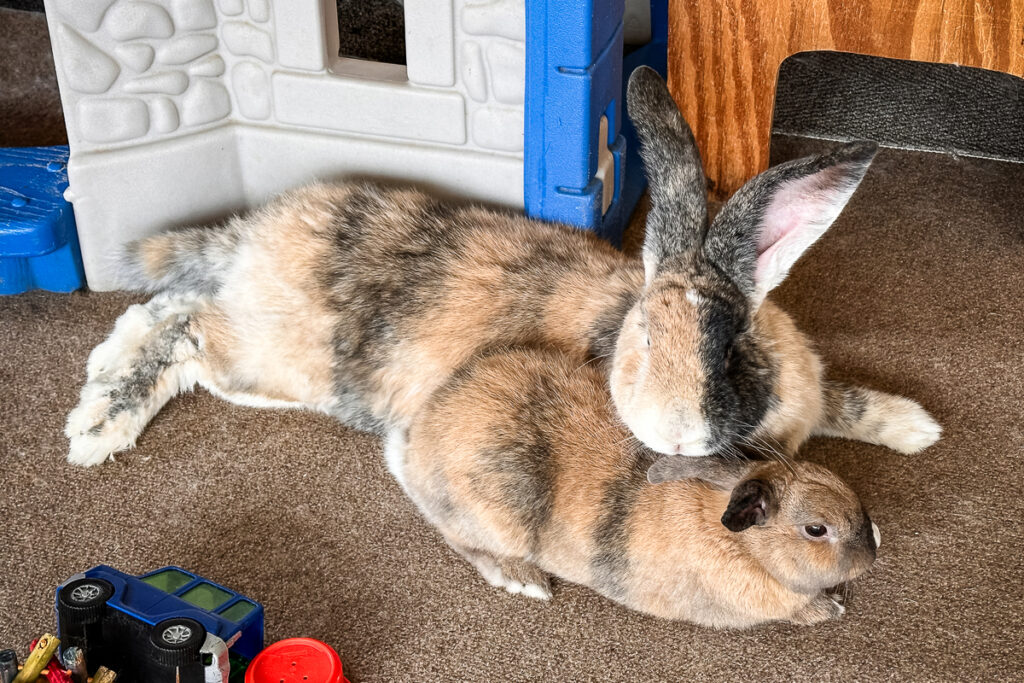Gymnastic toys—those that entice climbing on, leaping over, running through, diving into, or sliding down—keep bunnies physically fit. Smaller toys—those that spring, swing, bounce, roll, or make noise—keep rabbits mentally engaged.
Chew toys of any size should be of untreated, non-toxic material. Natural wicker items, such as those made from cane, rattan, willow, reed, and bamboo are good choices. Rabbits need plenty of indigestible organic fiber, but not the synthetic fiber in your carpet or sofa.
Nudge-and-roll toys are propelled by bunny’s nose, but sometimes they are tossed or chewed instead, They include large plastic balls or woven willow balls, empty soup cans or salt cartons, paper-towel spools, and toilet-paper spools. When you stuff a spool with hay, it becomes a chew toy rather than a roll toy, and it will soon disappear. Even though stuffed spools need to be replaced frequently, you have an ongoing source of spools.
Climbing toys for human toddlers can entice your bunny to climb and leap.
Ramps can be used for bunnies to get where they want to go—and exercise on the way.
Tunnels: Wicker tunnels are available in pet supply stores. Cardboard concrete forms, sold in building supply stores, also make good tunnels. Packed with paper, they can be digging projects. Towels on a slick floor provide something for bunny to scoot around, bunch up, spread out, pat then roll up and scoot around again.
Hay tub: This is more than a litterbox topped with hay, so make it deep enough to dive into and dig around. The exercise is not in eating hay but jumping in and out of a deep tub or box.
Baskets/boxes: large ones in a stack attract bunnies to climb and explore. Small ones are good for chewing. Wicker baskets come in many sizes and shapes. Bunnies love them all. You can find them at pet-supply shops or at www.busybunny.com.
Loose straw is for chewing exercise rather than nutrition. Offer it in a bale, a bag, or a large box.
Organic-fiber rugs include sea-grass rug squares, rice mats, and bamboo mats, which can be chewed if pesticide free (check supplier sources).
Newsprint paper is popular with rabbits. Though some of it may be chewed and swallowed, the main attraction is shredding. Bunnies like the sound of paper ripping.
Wooden chewables include well-dried tree branches or dried firewood with bark (check toxicity list on page !”), Also, non-toxic wooden blocks and other baby toys are safe for rabbits, as well as furring strips used for bunny-proofing baseboards.
Jingle-rattle toys are tossed, batted, and shaken. They include plastic balls with bells, car keys, and hard-plastic baby rattles. Rabbits are quite imaginative with noisy toys at 3 a.m. Jingly items remain popular with rabbits well into their senior years. My old and severely disabled bunnies can still pick up their bells and balls and toss them from one place to another. Metal toys, after a few years of being urinated on or dunked in the water bowl, will eventually rust. Hard plastic toys can be washed repeatedly in hot soapy water and last for many generations.
Slinkies can come alive for rabbits as they do for game-playing humans. Rabbits like to pull them, shake them, and toss them. Put one in a box of assorted toys for your bunny to discover. If you attach slinkies or other “loopy” toys to the side or top of the pen, make sure they detach easily, in case your bunny’s foot becomes entangled. Some rabbit caregivers have discontinued all types of rigidly attached toys or hay hangers.
Cardboard as a box with cut-outs on the sides and top provides a hiding place, as well as a chewing project. It usually takes a few weeks for a rabbit to destroy a box, while having fun at the same time. Flat sheets of cardboard can serve as a floor covering that is scratchable and chewable.
Paper bags also have multiple uses. They can be hidden in or chewed and shredded. My rabbit Dickens was a notorious rug chewer until I started giving him brown grocery bags. He shreds them compulsively into tiny pieces. and we have no more holes in his rugs.
©Copyright Marinell Harriman. All Rights Reserved. Republished with the permission of the author.
Playthings - How Bunnies Use Them was originally published in House Rabbit Handbook (5th ed.).

